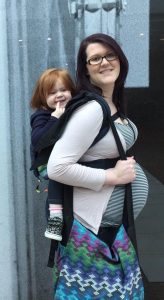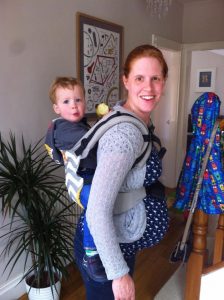Is carrying while pregnant safe? Many mothers wonder if they can safely continue to carry their children while pregnant with a new baby. For many, having established a close bond and finding the carrier they use of great value for comfort and practicality, they are keen to carry on carrying, both to meet their child’s needs for contact and for their own enjoyment.
“I knew that I needed to make the most of carrying my girl before her sibling was born as things were about to change for all of us. She needed me too, so I carried her as long as I could during my pregnancy. Her weight balanced out my bump and actually made my back pain more manageable by being corrective.” Jody
Other mothers may not have a choice, especially if there will be a small age gap between siblings and the older child is not yet walking reliably, or if he becomes worried by the impending changes to the family structure and needs extra closeness and reassurance. Sometimes it is just necessary.
“My little girl is very strong willed so if she wanted up for a carry while I was pregnant, it was simply the path of least resistance . There were a few times when she was poorly, others when she was tired or I simply had things to do. It was all about practicality and doing whatever made my day a bit easier.” Lindsay
It is worth reflecting on the fact that women around the world have, for many generations past, carried older children on their bodies while pregnant, so it is certainly possible to do. In societies where babywearing is a part of everyday life, child-carrying is traditionally shared around large families, with older siblings carrying younger ones, or close family members taking their turn, to lighten and distribute the load around the community. Women in more Westernised societies may feel much more isolated and unsupported by their local communities, so they may need to be able to carry their own children for longer periods and more often than in traditional societies.
Babywearing in pregnancy is indeed possible for the majority of women, if they are in good health and there is no medical reason to avoid lifting loads. Those who are already well used to carrying their toddler frequently will find it simple to continue; their body strength and tolerance has grown in pace with their child’s weight and little may need to change until the bump is large.
“We needed to walk the dog and I wanted to be able to go to the dog trials and carrying was much more convenient than a buggy. My body was used to carrying, so we just carried on!” Lucy
Those who are new to carrying (and looking for a solution for an uncertain or distressed older child) may find it more of a challenge, just as if they had a new job which required sudden frequent heavy lifting. In these circumstances, it would be wise to get some support from your local sling professionals to find out which slings will work best for you and be comfortable. They can help you learn how to get your bigger child up into a carrier safely without straining yourself, and be able to work with you to find solutions. Once equipped with an appropriate sling, it is wise to stick with carrying for short periods and gradually increase the duration of use. This all helps to build up endurance until pregnancy is well advanced.
First Trimester
The maternal body undergoes several changes during pregnancy which can have an impact on the type of carrying women find comfortable.
In the first trimester, symptoms such as 
All being well, however, most carriers can be used in early pregnancy; there is no need to fear that the growing baby will be squashed by waistbands, for example. On the whole, the carrier that has been used up until a mother discovered she was expecting again can continue to be used while baby’s body is still small and mostly contained within the pelvic brim. Front carries are still fine to use and hip and back carries are also appropriate.
This may be a good time to begin learning some new carries or investigating other slings in preparation for an enlarging bump. At this early stage, the toddler’s weight is still being distributed around the mother’s body and it is not resting on a bump, so there is time for both parties to begin initiating change whilst still being able to enjoy front carries.
If there is any discomfort from abdominal pressure, altering the type of carry can be very useful; front carries that don’t use a waistband could be considered, as could hip carries or back carries that avoid any central abdominal pressure. Meh Dais (and their variants) and woven wraps will offer high back carries in this circumstance, and can be tied in ways that have no knots around the middle at all (for example, “tying tibetan or candy cane”). A carrier with a waistband could be moved low down to settle around the hips (as long as the carried child remains snug and close enough to kiss with an uncompromised airway), or moved higher up nearer the ribs, whichever feels most comfortable.
Second Trimester
As a growing bump begins to have an impact on a mother’s shape, moving to hip or back carries may feel much more comfortable. Front carrying may become awkward as the child will be very high and it is best to avoid a heavy toddler’s weight sitting on top of a bump.
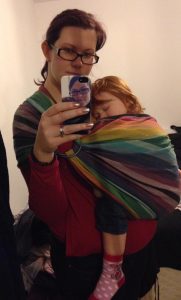
Those who love ring slings and other hip carriers have often already learned how to minimise these alignment issues with familiarity and experience, and can always benefit from being reminded!
It is worth being aware that prolonged hip carrying in pregnancy may also have an impact on the pelvis and its stability, especially as ligaments begin to soften and loosen in preparation for birth. If you begin to experience any discomfort with carrying (if not related to inexperience) then it is sensible to check your posture to make sure your spine is not twisting, try frequent switching of sides, reduce the duration of carrying, and see your local specialist for support. Some women suffer from Symphysis Pubis Dysfunction and may find hip carrying inadvisable.

Logistically, waistbands may begin to become difficult to fit above the bump and may no longer be as supportive due to the changing angle of the band and how it functions when distributing weight around the pelvis. It is up to the individual to decide when the waistband is no longer the best option. At this stage, carriers with floppy soft waistbands that will mould around the mother’s shape, or no waistband at all, may be more useful. Meh Dais with flexible waists that can be carefully tied, or podaegis or onbuhimos or woven wraps tied in such a way that the carry has no waist at all may be very helpful.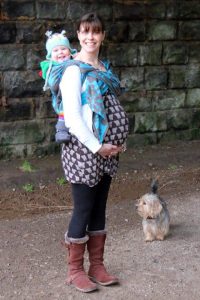
Learning how to do this well and comfortably may need practice and building-up of strength due to the new position and a local sling professional can help.
 Third Trimester
Third Trimester
In this last part of pregnancy, the maternal body is now carrying a significant extra load every day; movement may feel more cumbersome and the mother may wish not to carry any more than she has to. Furthermore, the levels of relaxin hormone increase significantly; ligaments and tendons soften and become more elastic. This helps the pelvic outlet to widen ready for delivery and also loosens and softens the intercostal muscles and ligaments between the ribs to allow expansion of the chest diameter for the growing baby. These changes will all affect load-bearing and every pregnant mother will vary in what she feels able to do; each successive pregnancy will also affect carrying ability.
In the third trimester, high, supportive back carries with soft slings tend to work best; woven wraps in multiple layer carries or supportive single layers are useful, as are meh dais and their variants, as well as the waistband less onbuhimos, all of which keep toddler weight high, snug and central, minimising any uneven pressure on the pelvis and spine, and also balancing out the weight of the bump. Carrying may be only for short periods, and hip carries are best kept to a minimum.
Once baby has been born, the maternal body will take some time to recover from the huge changes of preparing for labour; and then the process of labour and birth themselves. It may be some time before a mother feels well and strong enough to begin carrying her toddler again; the pelvic floor and stretched abdominal muscles need time to re-tone and strengthen. For this reason, many experienced professionals will advise post-partum women to consider carrying just their newborn for the first few weeks and months, and then begin to carry their toddler again in front carries before they consider re-starting back carrying. Methods for getting a heavy toddler on the back will need to be considered; swinging and scooting methods may place inappropriate strain on still-recovering ligaments and muscles. This will of course depend on individual circumstances; back carrying may be preferable to pushing heavy buggies. Tandem carries may be necessary from an early stage, and it would be wise to visit your local sling professional to get some support with carrying two children in this way if you are not experienced.

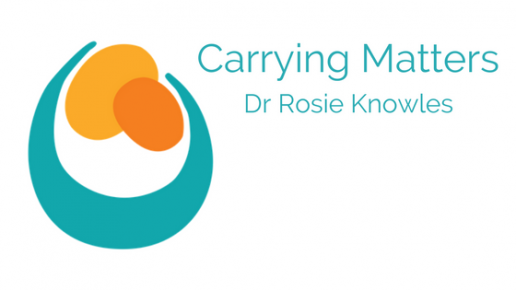
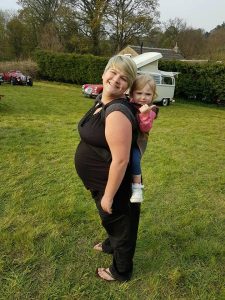
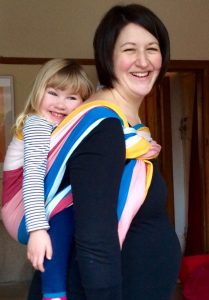

 Third Trimester
Third Trimester